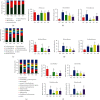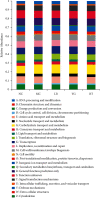Effects of Lacidophilin Tablets, Yogurt, and Bifid Triple Viable Capsules on the Gut Microbiota of Mice with Antibiotic-Associated Diarrhea
- PMID: 35360462
- PMCID: PMC8964159
- DOI: 10.1155/2022/6521793
Effects of Lacidophilin Tablets, Yogurt, and Bifid Triple Viable Capsules on the Gut Microbiota of Mice with Antibiotic-Associated Diarrhea
Abstract
Antibiotic-associated diarrhea (AAD) is a common morbidity caused by antibiotic use and is characterized by the dysbiosis of the gut microbiota. Several clinical trials have shown that probiotics can prevent AAD. This study aimed at investigating the effects of Lacidophilin tablets (LB), yogurt (YG), and bifid triple viable capsules (BT) on the gut microbiota of mice with AAD. Mice with diarrhea were randomly allocated to treatment groups or the control group and were treated with either LB, YG, BT, or vehicle control. The body weight, diarrhea scores, cecum index, and cecal length were determined. Fecal samples of all mice were analyzed using 16S rRNA high-throughput sequencing. The results showed that LB, YG, and BT significantly decreased the diarrhea scores and inhibited increases in the cecum index and cecal length induced by AAD. In addition, they significantly changed the composition and richness of the gut microbiota. Specifically, they increased the abundance of the phylum Firmicutes and decreased the abundance of the phyla Bacteroidetes and the family Bacteroidaceae. Treatment with LB and YG also decreased the abundance of the phylum Proteobacteria and only LB could mediate the reduced levels of Lactobacillaceae in AAD mice. At the genus level, YG and BT treatment decreased the abundance of Bacteroides or Parasutterella. To our surprise, only LB treatment dramatically increased the abundance of Lactobacillus and decreased that of potential pathogens, such as Bacteroides, Parabacteroides, and Parasutterella, to almost normal values. Our findings indicate that LB, YG, and BT ameliorated diarrhea by regulating the composition and structure of the gut microbiota and that LB plays an important role in regulating the gut microbiota.
Copyright © 2022 Ni Yang et al.
Conflict of interest statement
The authors declare no conflicts of interest.
Figures




Similar articles
-
Complex probiotics alleviate ampicillin-induced antibiotic-associated diarrhea in mice.Front Microbiol. 2023 Apr 14;14:1156058. doi: 10.3389/fmicb.2023.1156058. eCollection 2023. Front Microbiol. 2023. PMID: 37125182 Free PMC article.
-
[Modulation of gut microbiota during alleviation of antibiotic-associated diarrhea with Zingiberis Rhizoma].Zhongguo Zhong Yao Za Zhi. 2022 Mar;47(5):1316-1326. doi: 10.19540/j.cnki.cjcmm.20211129.702. Zhongguo Zhong Yao Za Zhi. 2022. PMID: 35343160 Chinese.
-
Poria cocos Polysaccharide Ameliorated Antibiotic-Associated Diarrhea in Mice via Regulating the Homeostasis of the Gut Microbiota and Intestinal Mucosal Barrier.Int J Mol Sci. 2023 Jan 11;24(2):1423. doi: 10.3390/ijms24021423. Int J Mol Sci. 2023. PMID: 36674937 Free PMC article.
-
Current understanding of antibiotic-associated dysbiosis and approaches for its management.Ther Adv Infect Dis. 2023 Feb 24;10:20499361231154443. doi: 10.1177/20499361231154443. eCollection 2023 Jan-Dec. Ther Adv Infect Dis. 2023. PMID: 36860273 Free PMC article. Review.
-
Altered Composition of Gut Microbiota in Depression: A Systematic Review.Front Psychiatry. 2020 Jun 10;11:541. doi: 10.3389/fpsyt.2020.00541. eCollection 2020. Front Psychiatry. 2020. PMID: 32587537 Free PMC article.
Cited by
-
The effects of dairy on the gut microbiome and symptoms in gastrointestinal disease cohorts: a systematic review.Gut Microbiome (Camb). 2024 May 7;5:e5. doi: 10.1017/gmb.2024.2. eCollection 2024. Gut Microbiome (Camb). 2024. PMID: 39290657 Free PMC article. Review.
-
Comprehensive gut microbiota and metabolomics combined with network pharmacology reveal the effects of acupuncture treatment for chemotherapy-induced nausea and vomiting.Transl Gastroenterol Hepatol. 2025 Apr 14;10:26. doi: 10.21037/tgh-24-35. eCollection 2025. Transl Gastroenterol Hepatol. 2025. PMID: 40337760 Free PMC article.
-
Beneficial insights into postbiotics against colorectal cancer.Front Nutr. 2023 Mar 10;10:1111872. doi: 10.3389/fnut.2023.1111872. eCollection 2023. Front Nutr. 2023. PMID: 36969804 Free PMC article. Review.
-
Natural Bioactive Compounds Enriched Functional Yogurt: Impact on the Probiotic Bacteria and Its Potential Health Benefits.Probiotics Antimicrob Proteins. 2025 Feb 12. doi: 10.1007/s12602-025-10461-1. Online ahead of print. Probiotics Antimicrob Proteins. 2025. PMID: 39934501 Review.
-
Lacidophilin tablets relieve irritable bowel syndrome in rats by regulating gut microbiota dysbiosis and intestinal inflammation.Sci Rep. 2025 Mar 9;15(1):8151. doi: 10.1038/s41598-025-91883-3. Sci Rep. 2025. PMID: 40059226 Free PMC article.
References
-
- Si L., Ml H., Dan L. Involvement of bacteria other than Clostridium difficile in antibiotic-associated diarrhoea. Trends in Microbiology . 2016;24(6):463–476. - PubMed
-
- Sun L., Yan Q., Lu C. Effects of Panax ginseng polysaccharides on the gut microbiota in mice with antibiotic-associated diarrhea. International Journal of Biological Macromolecules . 2019;124:931–937. - PubMed
-
- Pax P., Agir R., Agis B. Saccharomyces boulardii for the prevention of antibiotic-associated diarrhea in adult hospitalized patients: a single-center, randomized, double-blind, placebo-controlled trial. American Journal of Gastroenterology . 2012;107(6):922–931. - PubMed
LinkOut - more resources
Full Text Sources

